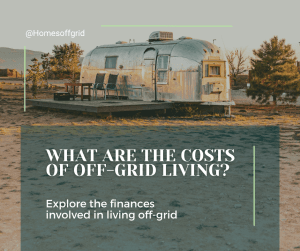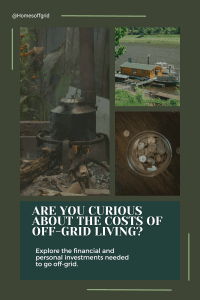Embracing the off-grid lifestyle has ignited a spark of curiosity and interest among those seeking a more meaningful way of living. As fascination grows, so does the desire to understand the true investment involved. In fact, one of the biggest questions when it comes to researching off-grid living is “What does it cost?”. Read on to discover the most significant costs of off-grid living, and explore the financial, logistical, and lifestyle factors that shape this unique way of life.

Financial Costs of off-grid living
When it comes to living off-grid, there’s an upfront investment that sets the stage for self-sufficiency. Not only must you purchase your off-grid home, but you must also account for the costs of solar panels, batteries, water collection systems, and other essential infrastructure. While the initial expenses can vary greatly depending on factors like location and energy needs, it’s crucial to view them as an investment in your future independence.
It’s important to dispel the myth that off-grid living is always cheaper in the long run. While you can certainly reduce or eliminate utility bills, the costs of maintaining and upgrading your off-grid systems can add up. Regular maintenance, occasional repairs, and technology updates are all part of the financial equation. But investing in these systems isn’t just about money; it’s about being in control of your own energy and resources.
Lifestyle Adjustments
Off-grid living isn’t just a lifestyle change; it’s a whole new world to navigate. Self-sufficiency becomes a key principle, with a strong emphasis on producing your own food and managing resources efficiently. These adjustments often mean expenses associated with acquiring new skills. Learning about energy management, waste disposal, and sustainable farming practices might involve investing in education and training.
Additionally, the initial costs of creating a self-sustaining garden or raising livestock can be substantial. While these costs contribute to your overall independence, they’re essential to consider when calculating the expenses of off-grid living.
Limited Access to Amenities
Living off-grid also means forgoing some modern conveniences. There are many amenities that you might take for granted when living in a ‘normal’ home, but when you go off-grid you might need to get creative if you still need these things.
While the allure of disconnecting from the constant digital stream may be part of the appeal, it’s important to recognise that alternative internet options may be required and that often comes with additional costs.
You will likely have to be more considerate when using resources like hot water because in an off-grid setting there is usually a limited supply. Unless you spend more money on infrastructure and fuel for an ‘unlimited system’ you may need to plan your usage based on things like solar availability, or whether you can heat extra water over a fire.

It might also be necessary to establish your own self-sufficient practices such as making bread, and carefully planning shopping trips because most off-grid homes, are in more rural locations, not within close proximity to supermarkets or other shops. This can even be true for mobile off-grid homes as you can’t always find suitable parking or mooring near built-up areas.
Adapting to a life where convenience takes a back seat to self-reliance requires a mindset shift. The costs of making this transition can manifest in various ways, from investing in alternative communication methods to learning to produce or source goods independently.
Regulatory and Legal Considerations
Navigating the legal and regulatory landscape is another aspect of off-grid living that can come with unforeseen expenses. These regulations can vary from country to country and even between different counties or states. Across Europe, there are building regulations and planning permission laws to adhere to, while in the USA zoning restrictions and building codes play a pivotal role. It’s essential to conduct thorough research to avoid unexpected costs and complications.
In some cases, compliance with regulations may require adjustments to your off-grid setup, which could lead to additional expenses. While these costs might not be as obvious as infrastructure investments, they are an integral part of the financial equation.
Health and Medical Considerations
Living off-grid, particularly in remote areas, can impact access to medical facilities. While the physical and psychological rewards of connecting with nature are abundant, it’s crucial to factor in potential health-related expenses. Investing in comprehensive medical resources, first aid training, and supplies can be essential for your well-being.

The costs of ensuring your health and safety while living off-grid are an aspect that deserves careful consideration. By evaluating your health needs and understanding potential medical challenges, you can better prepare for unexpected expenses. These investments ensure not just your physical well-being, but also your peace of mind as you venture into this alternative lifestyle.
Social and Emotional Costs of Off-Grid Living
Off-grid living often brings solitude, as interactions with neighbours and communities may be limited. This isolation can have emotional costs that should not be overlooked. Maintaining social connections requires proactive efforts and may involve additional expenses, such as travel to connect with like-minded individuals or participating in events that foster a sense of community.
Caring for your mental and emotional well-being is integral to a fulfilling off-grid experience. Allocating resources for activities that help you stay connected and engaged is an important part of the overall cost calculation.
Living on the Water: A Unique Investment

Taking off-grid living to the water initially entails investing in your boat. Beyond the financial aspects of purchasing and maintaining a vessel, you’ll also need to consider mooring fees, repairs, and outfitting for self-sufficiency. These alternative expenses associated with ‘boat life’ are important to take into account if you are considering life on the waterways.
Embracing Mobility: Life in a Vehicle
For the wanderers at heart, an off-grid lifestyle can be lived on wheels. From the cost of the vehicle itself to modifications for sustainable living, maintenance, and essential resources, this option has its own financial landscape. There are also vehicle inspections and insurance to account for; depending on your vehicle type you may need to travel further for your inspection, and insurance rates for ‘live-in’ vehicles can vary considerably. Investing in a mobile off-grid home has its own specific monetary factors but being able to live your life on the road makes it worth it when that’s your goal.
Conclusion: Weighing Investments and Rewards
Calculating the expenses of living off-grid goes beyond looking at the numbers. It’s also an investment of heart, soul, and resources. While the pull of sustainable self-sufficiency is strong, it’s essential to recognise the various costs that come with this lifestyle. As you consider these investments against the backdrop of rewards, you’re embarking on an adventure that’s uniquely yours.
By carefully weighing the costs against the rewards, you can make an informed decision, and ensure you have the best chance of being successful with your off-grid endeavours. There is no definitive answer to the question “How much does it cost?” as everyone’s journey is different, but if you decide that it’s worth the investment then the results could be inspirational.

To discover the financial costs of building an off-grid home check out this article.
To find out more about off-grid living explore the Reading Room.


